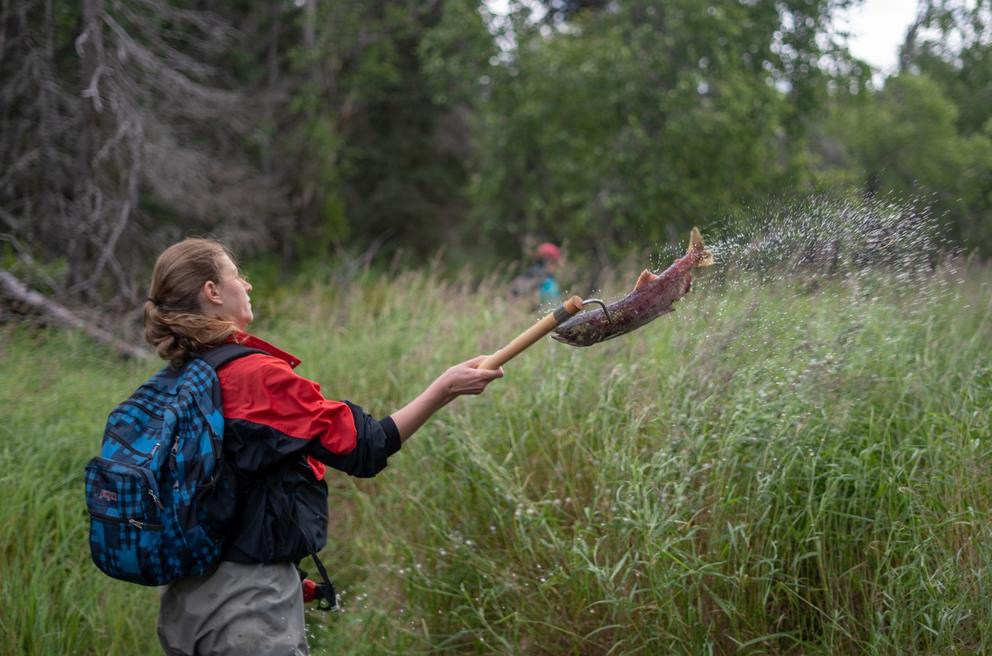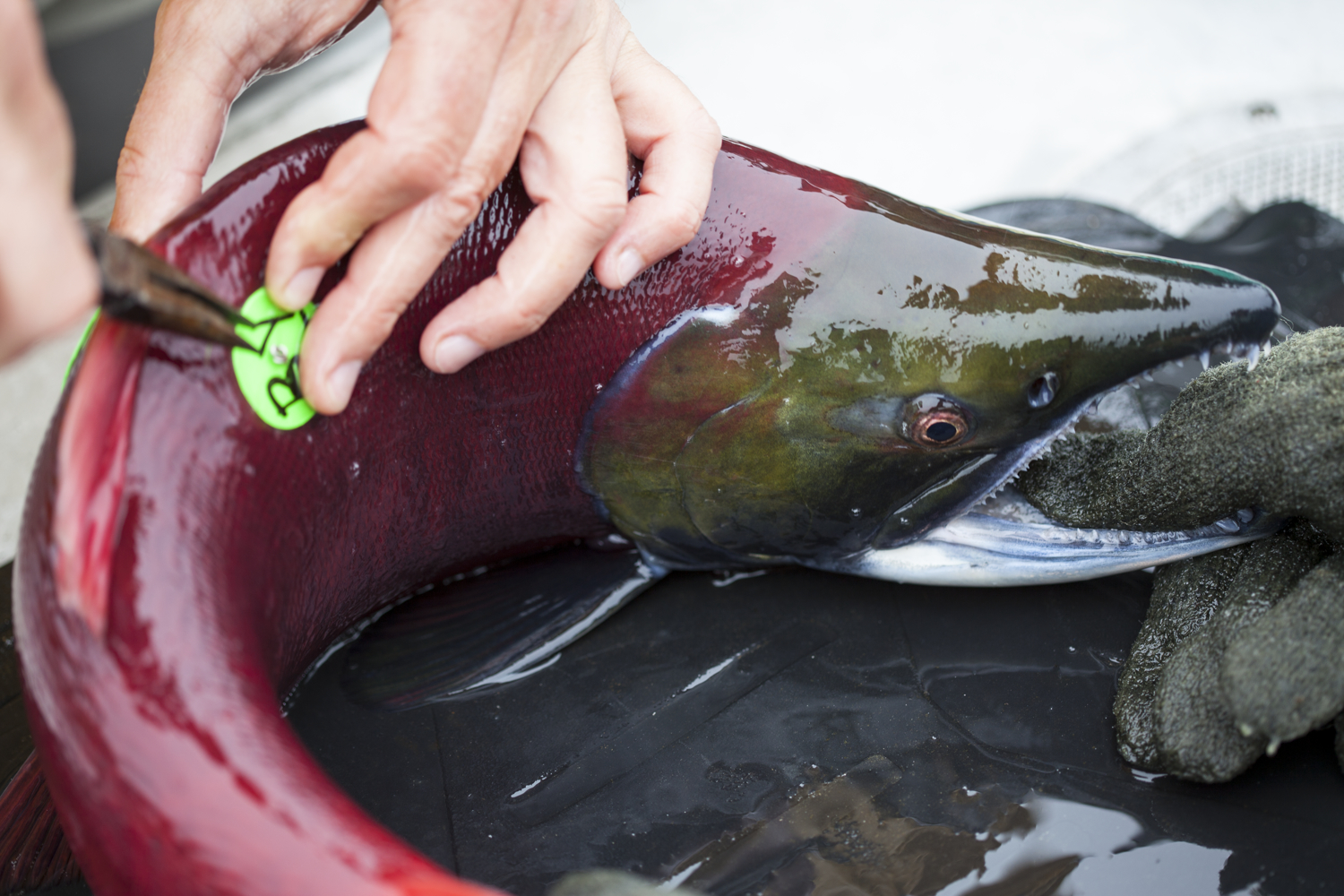Austin and her colleagues are spending their summers counting salmon carcasses for science. Red and fresh or pale pink and decomposing, the dead ones students need can be found floating under a curtain of overhanging grass or caught in knotty tree roots, Austin says. They log the carcasses in the day's tally, then grab gaffs — long wooden sticks with barbed ends — and swiftly maneuver the hooks into expired skin. Using a motion much like a baseball check swing, they toss them into the old-growth spruce forest flanking the bank.
“There's an art to hooking them decoratively over a broken branch or flinging for distance up a steep bank,” says Austin, who participated in the study between 2016 and 2018.
Just another day in the Alaska Salmon Program, where scientists fling fish daily at Hansen Creek during the summer spawning season. Throwing them isn't just macabre fun. Tossing fish out of the stream and deep into the forest ensures that researchers won’t accidentally count a carcass twice. Distance is key: Fish left too close to the bank could inadvertently be counted as bear leftovers, which would distort a simultaneous bear predation study dependent upon the same salmon population data.
Students come and go, but over the past two decades, Dr. Thomas P. Quinn has somehow convinced around 200 participants to sweat in the sun and whip 600,000 pounds of salmon carcasses (590001.106 pounds, to be exact) exclusively onto the leftmost, north-facing bank of Hansen Creek. The results of the exercise are helping us understand just how salmon carcasses (or a lack thereof) function as a driver for river ecosystems of the Pacific Northwest. And with 20 years of meticulously collected data, Quinn's patient, precise approach has led to some surprising findings about how the presence of dead salmon affects the long-term growth of the trees themselves.
That insight required more than just counting and a good arm. To judge growth at the end of a 20-year study, Quinn and fellow researchers sampled needles from 84 white spruce trees — 44 on the ‘salmon-enhanced’ bank and 40 on the unenhanced bank — to later analyze nitrogen and stable isotopes. They also took tree cores spanning 40 years of growth (tree cores show a cross-section of tree rings from the center of a trunk outward, so scientists can compare growth year over year).
Core testing was left to colleagues at Western Washington University like Dr. Andy Bunn (“Dare we say that's his core area of research,” Quinn says). The WWU team analyzed the cores from trees that were at least 40 years old. Their goal: to compare growth rates year-over-year between the 20 years covered by Quinn's study period, and rates during the two decades prior to that, in which salmon carcasses were deposited equally between both banks.
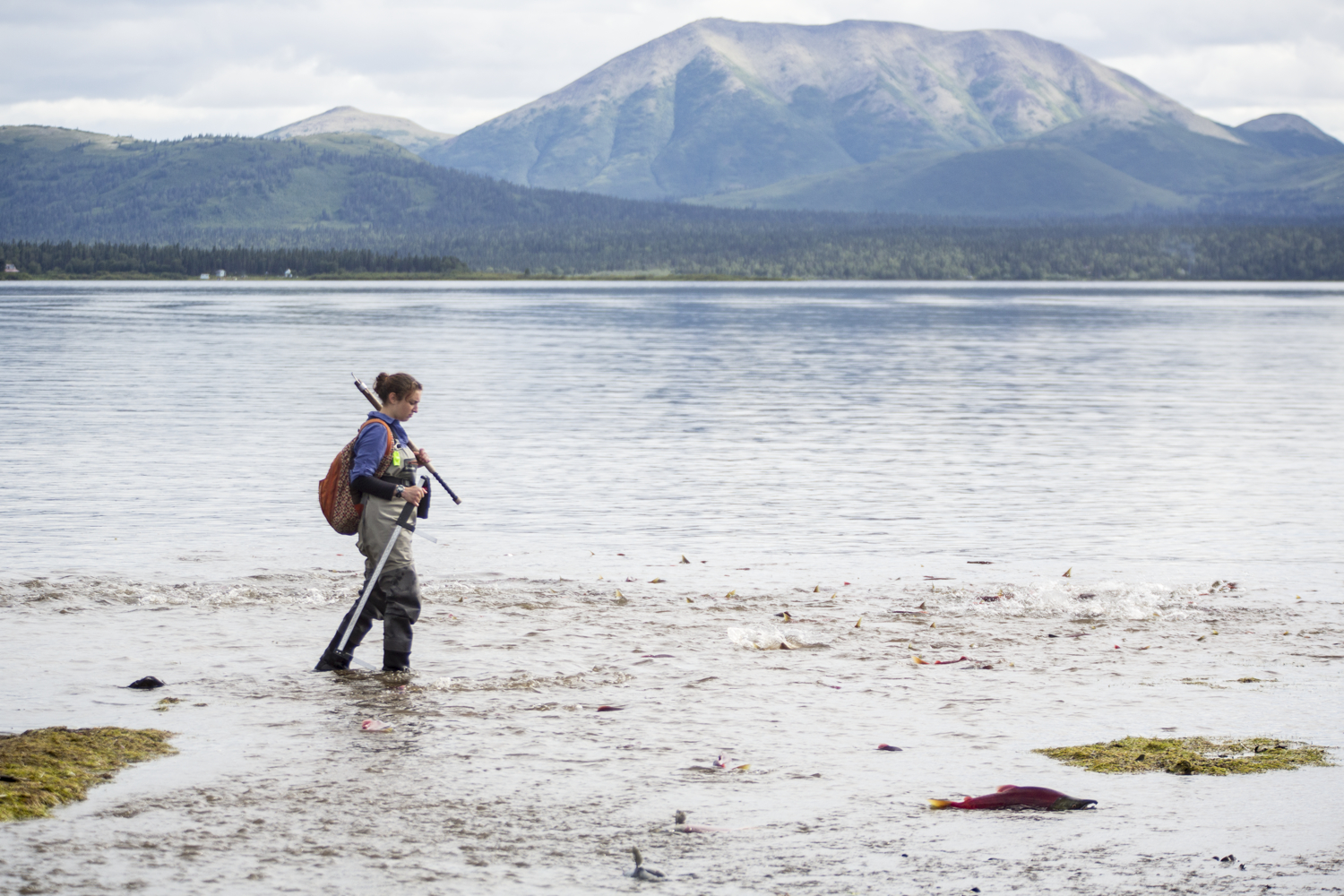
Together, these tests assessed whether the trees grew faster over this 20-year period than the 20-year period preceding it (they did); and whether fish fertilizer was a reason for that (it was). Last month, Quinn published a study in the journal Ecology based on this markedly time-intensive side project.
The Alaska Salmon Program began as a way to assess the health of fish, but it's grown into an ambitious and far-reaching collection of ecology studies for the UW. Its studies are doing more than exploring the interactions of fish, bears, trees, and other elements of creek ecology: Because they've happened over decades, the slow-science experiments are helping scientists see a fuller picture of ecosystem dynamics that might not become apparent without that time investment.
And as with so many things in the Pacific Northwest, dead fish are at the root of it.
How’d all this get started?
It takes a certain kind of person to commit time and energy to a physically strenuous 20-year study on a whim — much less convince others to join him.
“A stubborn one?” suggests Quinn, who’s been studying Alaska’s Bristol Bay region since 1987 and Hansen Creek since 1993. “There's always a sacrifice in doing long-term research. It ties you to that place," he says. While salmon drew him into ecological research, his interests eventually expanded to study how predators like bears affect salmon-heavy ecosystems.
“I decided that careful study of one stream would allow us to develop some more refined questions and precise answers,” he says.
Focusing on one stream allowed Quinn the opportunity to investigate an under-studied aspect of salmon-based ecosystems. Riverside trees ultimately fall into the water, creating places for fish to spawn, and salmon contain nutrients that fertilize the nitrogen-deficient spruce trees. The study raised questions: How essential are salmon carcasses to their ecosystem’s overall health? Are they part of a feedback loop that impacts the dynamics of their habitat?
Quinn realized Hansen Creek provided unique advantages for the research. The creek comes lined with spruce trees, which are naturally low in nitrogen. The researchers could easily attribute the flow of nutrients from salmon to trees by tracking nitrogen and stable isotopes. They also had a 20-year lead: UW researchers tracked salmon population data between 1977 and 1996 on Hansen's Creek. By assuming salmon had been distributed equally between both banks over that period and making some retroactive calculations, Quinn and his colleagues had baseline salmon weight estimates against which to compare the results of their recent 20-year study.
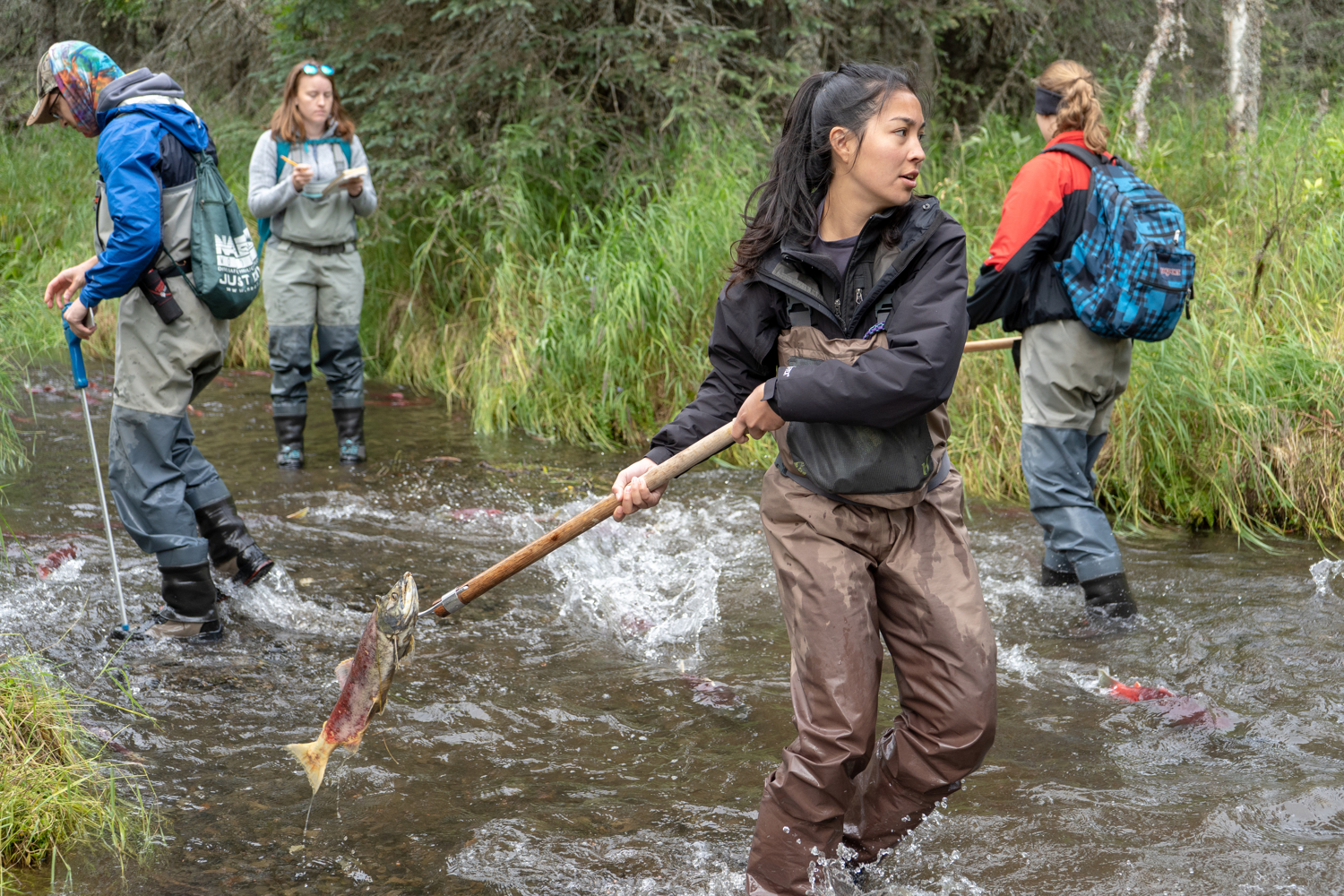
“We had a before-and-after experiment. We were able to not just say ‘salmon or no salmon,’ but also to quantify very carefully the number and the mass of salmon on each side of the stream, and that allowed us to account for the natural variation between the two sides in growth,” Quinn says. The measurement isn’t perfect, but he isn’t concerned.
“Any time you’re working back into the past to time when things weren’t sampled with the intensity of the present, you obviously have some assumptions to make and some degree of fuzziness.”
Keeping the ball rolling
But there were challenges convincing others to believe in the research — and continue funding it.
“It’s not necessarily glorious if you tell people you're gonna do this year what you did last year,” Quinn says. “It's hard to convince people that these long-term studies pay off, and yet once you find something interesting, everybody says, ‘Well, of course, we should have long-term work.’"
The work itself is grueling. In 2014, a peak year for salmon in Hansen Creek, researchers struggled against a stream teeming with as many as 20,000 live salmon a day. “We were throwing 3- to 5,000 a day with no apparent diminishment in the number because they just kept coming up from the lake. It was like there was some endless conveyor belt, an Escher diagram,” Quinn says.
But Quinn’s collaborators didn’t flag, and neither did his enthusiasm. To keep people excited about logging fish data in the field, Quinn says, “it’s all carrots with me.”
“Some of the students — particularly some of the guys, I admit — kind of make a contest out of seeing how far they can fling [the fish], whether they can get them stuck up a tree and so forth, but I don’t discourage that because you've gotta keep the morale up,” he says.
He also runs an annual betting pool based on fish longevity. The team measures and then tag a number of salmon at the beginning of the season to track how long each lives; the students get to place $5 bets on up to two fish they think have the best chance of survival based on attributes like gender, weight, color and length. It’s a surprisingly complex gambit.
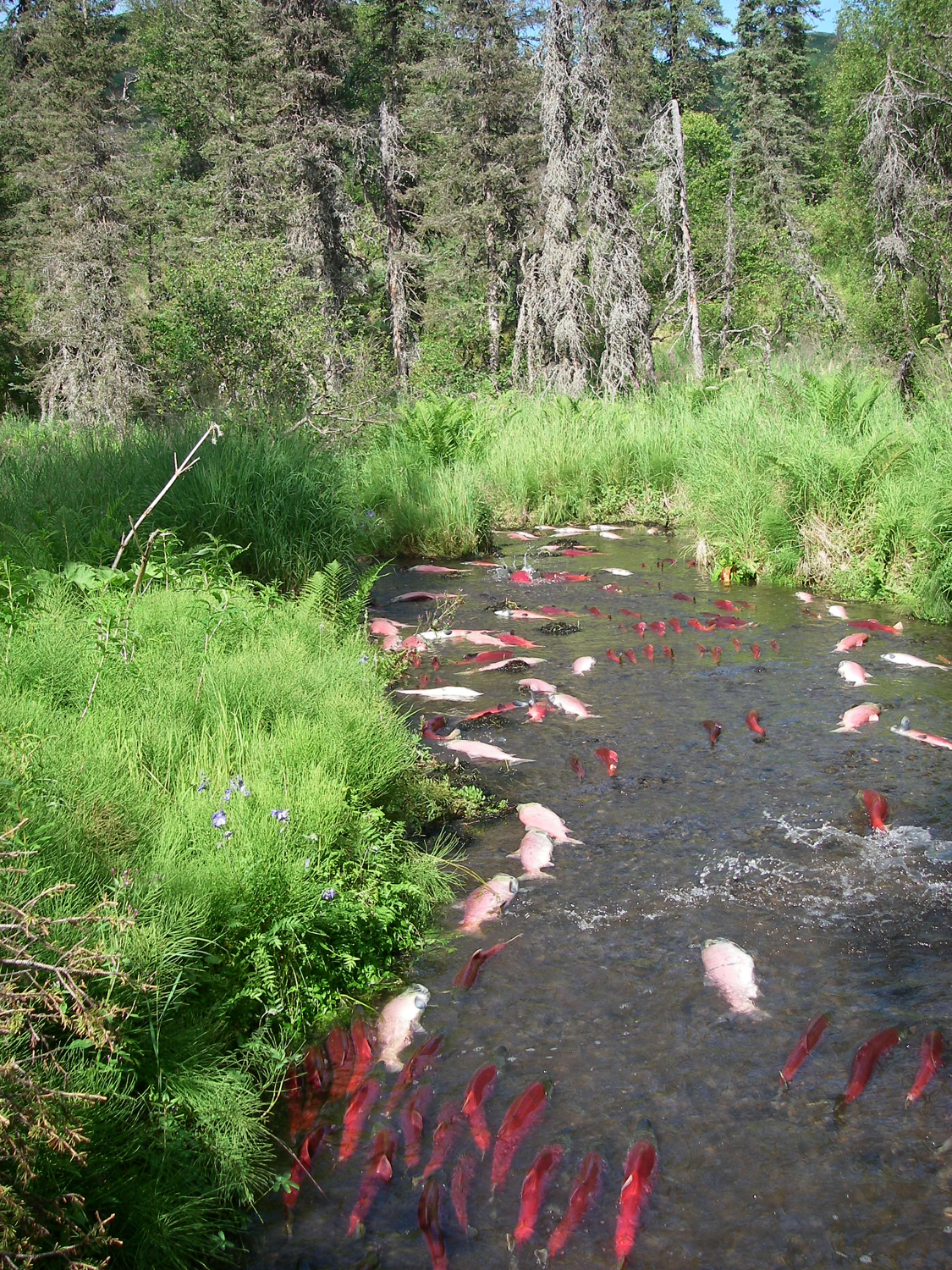
“Large salmon are more likely to be killed by bears… but maybe large salmon, if they're not killed by bears, will beat up smaller salmon, so the smaller salmon wouldn't live as long,” Quinn explains. “It gets the students thinking about the natural selection going on in the stream because natural selection isn't [just] something that happened in the past: It’s continuing with every generation. It's been an evolutionary ecology study as well as a nutrient-cycling study.”
But the most valuable incentive is the chance to assist in long-term research as an undergraduate — and even co-author the study. A recent paper in the journal BioScience found that STEM students involved in summer research were 48 percent more likely to pursue a STEM Ph.D. within six years compared to students who did not.
“I was treated very respectfully when I was an undergrad by some senior faculty members and I thought I would just pass it on,” Quinn says. “It's been one of my privileges of being a faculty member — I have opportunities to work with students and I involve them as collaborators rather than as underlings."
Working on this study gave graduate student Catherine Austin a deep well of experience, from coordinating field samplings and lab work to analyzing isotopes. But it also led to her first study co-authorship.
“I have two first-authored papers very close to publication right now, but having the model of this paper was instrumental in showing me, as a new grad student, how a research paper comes together, and showing me that I could do it, too,” Austin says. “Dr. Quinn is an enthusiastic teacher who is very committed to student learning… [especially] the hands-on field experience that often sparks a fire in students, even in an era in which running a lab class — let alone a field camp! — is increasingly costly and bureaucratically challenging.”
What’d they find?
Quinn and his team found that the trees grew faster after being fertilized with salmon, though the effect was modest. While this might seem disappointing to an outsider, Quinn remains fascinated by the details and the questions they might lead to.
“I think it’s an interesting result: There are other things that constrain the growth of trees in this area, like temperature, other nutrients in the soil, growing season, and so forth,” Quinn says. “There's a little bit of a mantra these days that ecosystems would be markedly changed if only there were more salmon in them, and it's important to bear in mind that there are limits.” He also noted that nutrient concentrations get diluted by growth: There may be more nutrients available after fish fertilization, but there’s more tree mass to nourish, too.
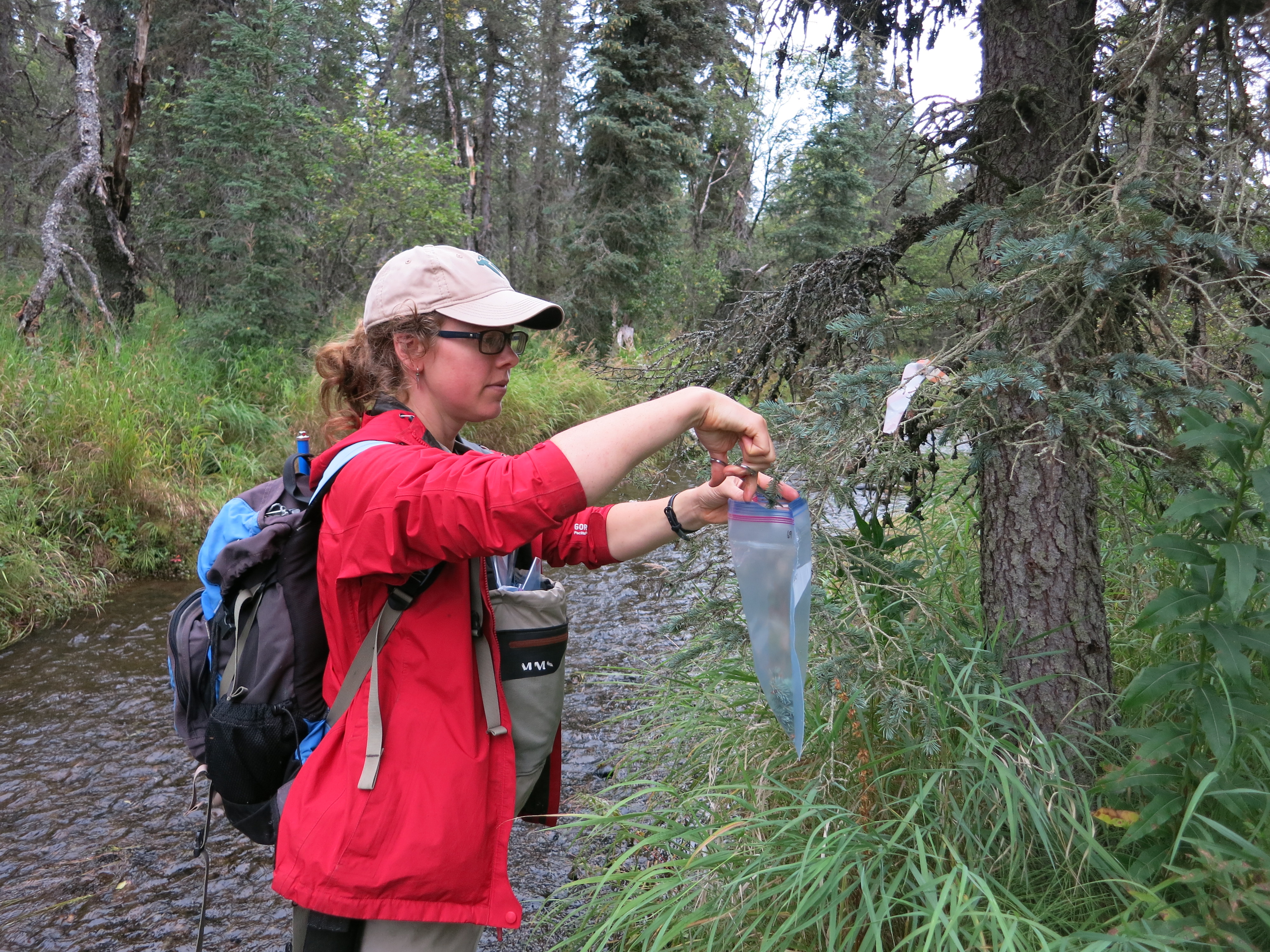
But the tests also yielded two surprising finds that put the tree growth in context. Researchers found that the trees on the fertilized side of the stream had been growing more slowly before the experiment; the fish tossing allowed them to catch up in height and growth rate to trees on the other bank. While studying nutrient absorption, they found trees on the unfertilized side maintained their nutrient density, suggesting that salmon can help trees sustain nutrient levels for decades beyond their presence in an ecosystem.
“If we’d only looked at the tree growth in the most recent 20 years, we would have said that there was no effect because the trees on both sides of the river would have been growing at the same rate, and we would have concluded the salmon had no effect,” Quinn says. “We actually would have missed the real result.”
The Alaska Salmon Program researchers are counting salmon carcasses on a daily basis through 2018, and Quinn says they will continue to do so as long as the program has enough resources.
"If I thought I could keep going another 20 years, I might," Quinn says.
Is it all worth it?
Both Dr. Robert Naiman, emeritus professor of Aquatic & Fishery Sciences at UW; and Dr. Carmella Vizza, a postdoctoral research scientist studying watershed biogeochemistry at Washington State University, say Quinn's research firmly demystifies a decades-long question about ecosystem feedback loops—particularly, the extent to which salmon death aids future salmon life.
“It’s really unusual to have such long-term studies like this, where people have the dedication and the perseverance to stay out there that long and do these things,” says Naiman, who has performed similar but shorter-term studies throughout the Pacific Northwest. "I'm a science advisor on the Columbia River Restoration and we really suffer from the fact that we don't have long-term data sets, whereas the UW Alaska [Salmon] Program has it. They really are publishing some groundbreaking studies right now.”
Vizza says she was impressed with Quinn’s results and experiment design.
“We rarely see such long-term experiments in ecology, but the duration was necessary to examine the effects of salmon nutrients on a long-lived species, such as white spruce,” she says. She was also excited to see Quinn use stable isotope analysis. This practice is often used to trace salmon nutrient uptake in the tissues of nearby plants and animals, but rarely to also show how those nutrients actually affect their recipients (in this case, trees).
Future impacts
The research could now help clarify mysteries surrounding other river ecosystems well beyond the Pacific Northwest.
For example, salmon might be more important to trees in some ecosystems than in others. Naiman has found in his research on salmon fertilization that in some places, such as the Southeast Alaskan rainforest, it takes less than 100 years for a salmon-enhanced tree to get to the size where it can fall into a stream and become salmon habitat; in the forests above waterfalls, which salmon can’t navigate, it can take over 300 years for the same tree species to reach that size.
The study — and the Alaska Salmon Program as a whole — also adds support to calls for more salmon protections. For instance, Naiman and his colleagues have spent lots of time near dams that prevent salmon from swimming upstream, and “in Oregon, within two to three years of [a dam installation], the trees slowed their growth rates down to levels that were expected from rivers that had no salmon.”
Salmon in Washington are a keystone species for 137 species, and support a $100 million fishing economy in the Puget Sound alone. But Sockeye salmon runs were notably low in Alaska this year, and the reasons why still aren’t clear. In the Pacific Northwest, Chinook salmon numbers have declined 60 percent since 1984 in part because of human intervention and climate change. Warming waters alone killed 250,000 sockeye salmon navigating the Columbia and Snake Rivers in 2015, prompting a U.S. District Court in Seattle to deliver a ruling last month that mandates the EPA to maintain cooler temperatures in the rivers. And last year, NOAA Fisheries salmon researchers came away with empty survey nets for the first time.
“In fall, every stream should smell of rotting dead salmon,” Quinn says. “I go to some of these streams and they don't smell of rotting dead salmon and I feel bad because I know that we’re missing something. Precisely how many more feet of timber do we have less? I don't know. Precisely how many bears do we have fewer? It's hard to be sure. But there's no doubt if you go to these systems that have rich salmon runs and good habitat, that there’s a richness that you just don’t see around here.”

